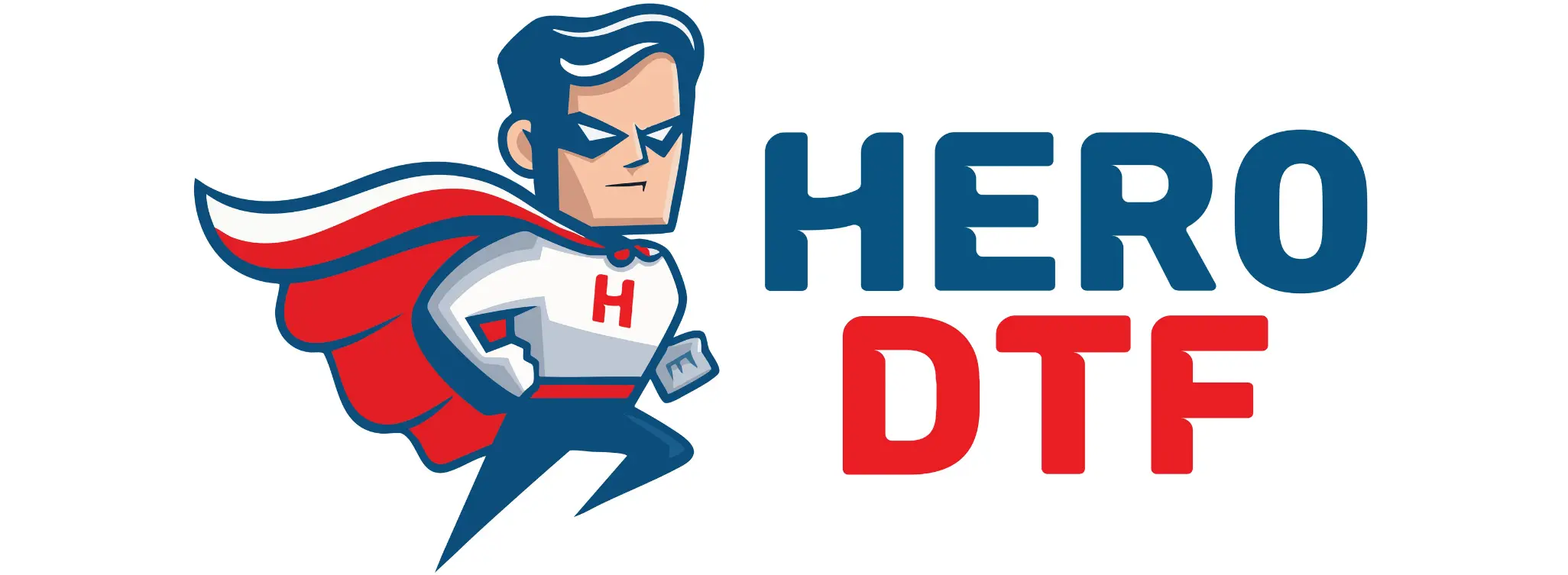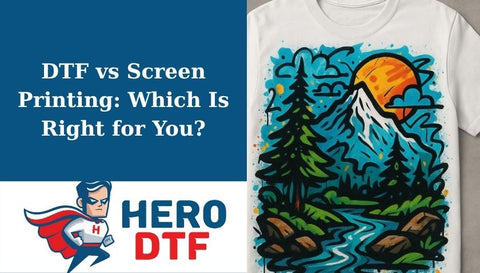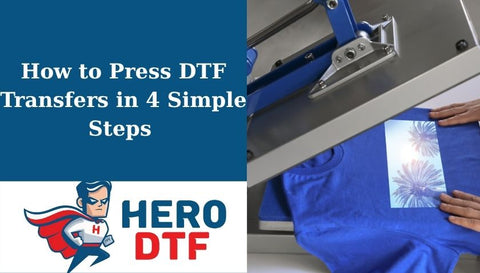Choosing the right printing method for apparel and textiles can greatly influence your product’s quality, production time, and profitability. Two of the most popular methods—DTF (Direct-to-Film) and traditional screen printing—offer unique advantages and trade-offs. Let’s break down both techniques to help you decide which one best fits your business model or creative needs.

Understanding DTF Printing
DTF (Direct-to-Film) printing is transforming the apparel decoration industry by offering a solution that blends quality, versatility, and speed. Unlike traditional printing methods, DTF doesn’t require screens, pretreatment, or long setup times. It delivers rich, full-color transfers onto a wide variety of fabric types—including cotton, polyester, blends, and even treated synthetics—with ease.
Its appeal lies in its ability to print vivid, detailed designs quickly and efficiently, making it ideal for print-on-demand services, small batch runs, or customized one-offs. DTF allows creatives and businesses to respond quickly to trends, customer requests, or online orders without having to worry about minimums, color limitations, or extensive production logistics.
DTF (Direct-to-Film) printing is a relatively new and rapidly growing technology in the custom apparel industry. It involves printing designs directly onto a PET film using specialized ink, applying a powdered adhesive, curing it, and then heat pressing the design onto the garment. It works on a wide range of fabrics including cotton, polyester, blends, and even treated nylon.
✅ DTF Advantages
-
Versatility: Adheres well to a variety of fabric types without pretreatment.
-
Full Color Output: Easily handles gradients, photo-realistic designs, and fine details.
-
Low Minimums: Great for short runs or one-off custom pieces.
-
Simple Process: No screens or color separations needed; print and press.
❌ DTF Disadvantages
-
Film Cost: PET film and powder adhesive can be more expensive per piece.
-
Limited Texture Options: Does not achieve the same soft hand feel as water-based screen printing.
-
Equipment Dependency: Requires a specialized printer, powder shaker, and heat press.
🛠️ DTF Process Overview
The DTF workflow is relatively straightforward compared to other print methods, but it requires the right materials and proper execution. Here’s how it works:
-
Print the Design: The digital artwork is printed in mirror mode onto a PET film using DTF-specific CMYK and white inks.
-
Apply Adhesive Powder: A hot-melt adhesive powder is spread onto the printed film. It sticks to the wet ink, forming the bonding layer.
-
Cure the Film: The powdered film is cured in a heating oven or under a hovering heat press. This melts the powder to prepare for transfer.
-
Transfer to Garment: The cured film is placed onto the garment and heat pressed at high pressure and temperature.
-
Peel and Final Press: After a few seconds, the PET film is peeled off (hot or cold peel depending on film type), and a final press is applied with parchment paper for finish and durability.
-
Design is printed on PET film with DTF ink.
-
Adhesive powder is applied.
-
Film is cured using a heat source (oven or press hover).
-
Film is heat pressed onto garment.
-
Final press softens and seals the design.
⏱️ DTF Production Time
One of the biggest advantages of DTF printing is the speed of execution, especially for short runs and customization. Since no screens, separations, or pretreatment are required, you can go from digital design to finished garment in under 10 minutes.
Production time for DTF typically breaks down as follows:
-
Printing and powdering a sheet: 2–4 minutes
-
Curing the powder: 2–3 minutes (depending on oven or press)
-
Heat pressing: 13–15 seconds for main press + optional 10–15 seconds for final press
DTF is ideal for on-demand orders, ecommerce fulfillment, and small-batch runs that need to be turned around quickly. Compared to screen printing, there’s significantly less setup and cleanup involved, making it ideal for dynamic, low-volume workflows.
-
Setup is fast and ideal for print-on-demand.
-
Time-efficient for complex, multi-color jobs.
🚫 Limitations
-
Heat-sensitive fabrics may not be ideal.
-
Not suitable for achieving a textured or vintage look.
>
Understanding Screen Printing
Screen printing—also known as silkscreen printing—is a time-tested technique that has been the cornerstone of garment decoration for decades. It involves creating a stencil (or screen) for each color in the design, and then pushing ink through the screen onto the fabric using a squeegee. This method is celebrated for its ability to produce durable, vibrant designs that last through extensive wear and repeated washing.
Although considered more traditional, screen printing is still widely used across the apparel industry—especially for high-volume jobs—thanks to its cost efficiency at scale and the variety of ink effects it can deliver. From plastisol and water-based inks to puff and glitter effects, screen printing gives designers a wide range of aesthetic and tactile options.
Screen printing is a traditional printing method that uses stencils (screens) to apply ink directly to fabric. Each color in the design requires its own screen, which makes it more time-consuming for complex or full-color designs.
✅ Screen Printing Advantages
-
Durability: Inks penetrate the fabric and can last for hundreds of washes.
-
Cost-Effective in Bulk: The more you print, the cheaper each unit becomes.
-
Textured Effects: Can create puff, metallic, glitter, or discharge effects.
❌ Screen Printing Disadvantages
-
Complex Setup: Requires separate screens and color separations.
-
Limited to Certain Fabrics: Works best on cotton and cotton blends.
-
Not Ideal for Short Runs: High setup costs make small jobs inefficient.
🛠️ Screen Printing Process Overview
Screen printing is labor-intensive but offers high consistency in bulk production. The typical process includes:
-
Design Preparation: Artwork is separated by color, and each color is printed onto a transparency.
-
Screen Creation: A mesh screen is coated with a light-sensitive emulsion. The transparency is placed on the screen, and it’s exposed to UV light to harden the emulsion and create a stencil.
-
Ink Application: Each screen is aligned on a press. Ink is pushed through the mesh onto the garment—one screen per color.
-
Curing: Once printed, garments are run through a conveyor dryer where the ink is cured at high heat to ensure durability.
Screen printing excels at consistent, high-speed production once the setup is complete. However, multicolor designs require multiple screens and precise alignment, making it less efficient for short runs or intricate photo-like graphics.
-
Design is separated by color.
-
Each color is burned onto a screen.
-
Ink is pushed through screens onto garments.
-
Garments are cured via conveyor dryer.
⏱️ Screen Printing Production Time
Screen printing is most efficient at scale, but it comes with a longer setup time. Preparing the screens, aligning them, and test printing before full production begins can take hours depending on the number of colors.
Once set up, however, the actual printing process is rapid—professional presses can print hundreds of garments per hour. Here's how time typically breaks down:
-
Screen creation and exposure: 30–60 minutes per design
-
Setup and alignment: 15–30 minutes per print run
-
Printing and curing: 1–2 minutes per shirt (fast in bulk)
This method is optimal for large volume jobs (e.g., 50+ units per design), where setup costs are spread over many prints, reducing the average unit cost significantly.
-
Long setup time, but quick printing once setup is done.
-
Better suited for bulk orders.
🚫 Limitations
-
Difficult to reproduce photo-quality images or fine gradients.
-
Not flexible for print-on-demand or customization.
DTF vs Screen Printing: A Side-by-Side Comparison
| Feature | DTF Printing | Screen Printing |
|---|---|---|
| Best for | Small runs, full color, diverse fabrics | Bulk orders, spot colors, durability |
| Setup Time | Minimal | High (screen creation required) |
| Print Detail | Excellent (photo-quality) | Moderate (flat colors preferred) |
| Durability | High (with final press) | Very high |
| Cost per Print | Higher for bulk | Lower for bulk |
| Fabric Compatibility | Most fabrics | Cotton & blends |
| Customization | Easy, flexible | Limited once setup is done |

Why DTF Might Be the Right Choice for You
For creators, small businesses, and growing print shops, DTF provides the flexibility, simplicity, and speed that traditional methods lack. Its low barrier to entry, combined with vibrant full-color output, makes it ideal for:
-
Personalized t-shirts
-
Low-volume fashion brands
-
On-demand ecommerce
-
Mixed fabric orders
DTF also excels in multi-SKU environments where each shirt might need a different name, color, or design. With zero screen setup and fast turnarounds, it's a modern solution for today’s customization-driven market.
While screen printing still holds strong for bulk runs and long-term durability, DTF is emerging as the go-to method for quality, versatility, and efficiency—especially in the age of one-off, custom, and fast-turnaround orders.
👉 Ready to start printing smarter? Visit New Jersey DTF for premium films, powders, and equipment to level up your production.



